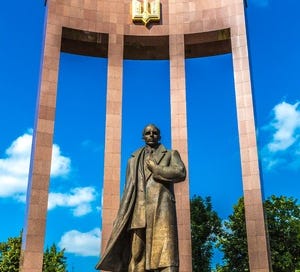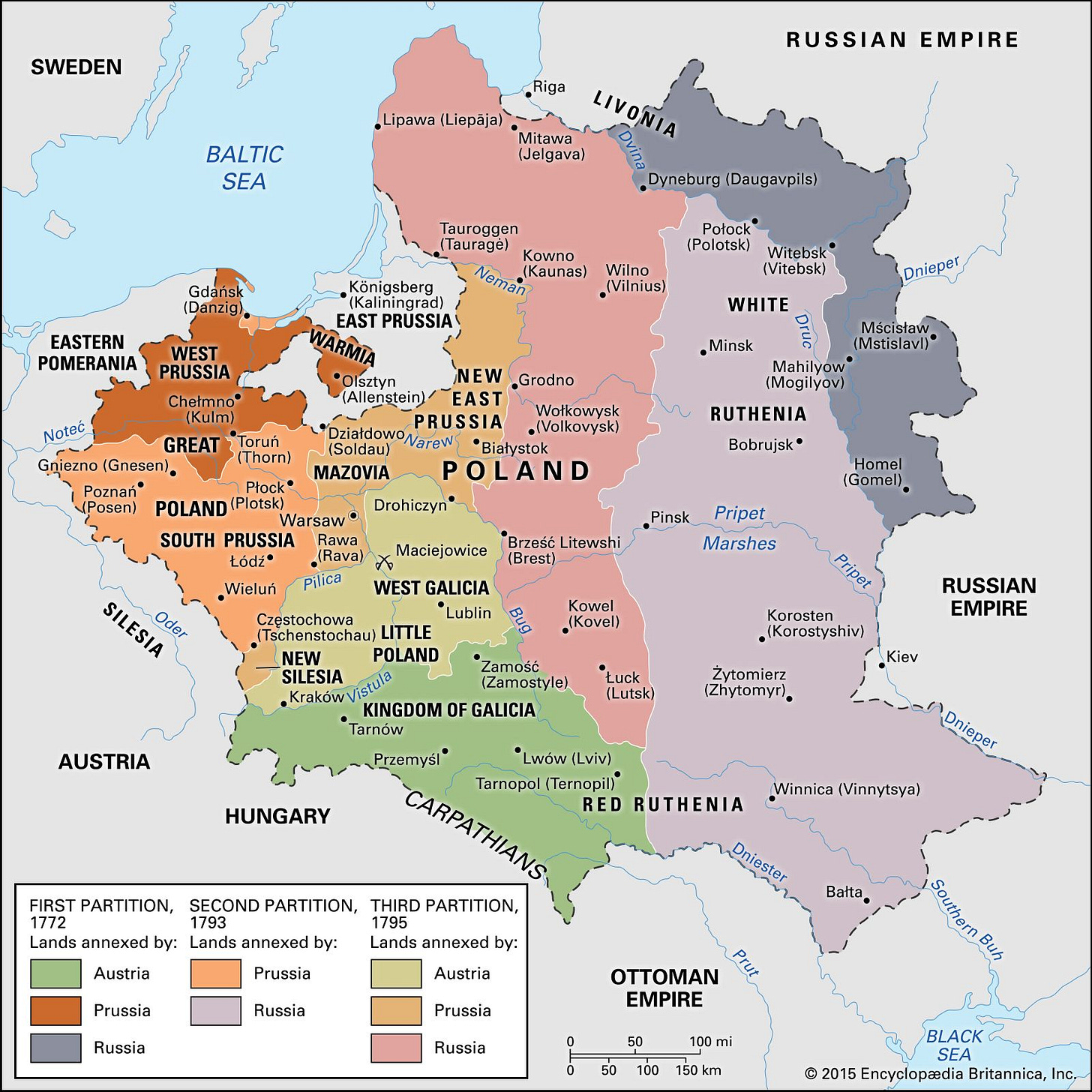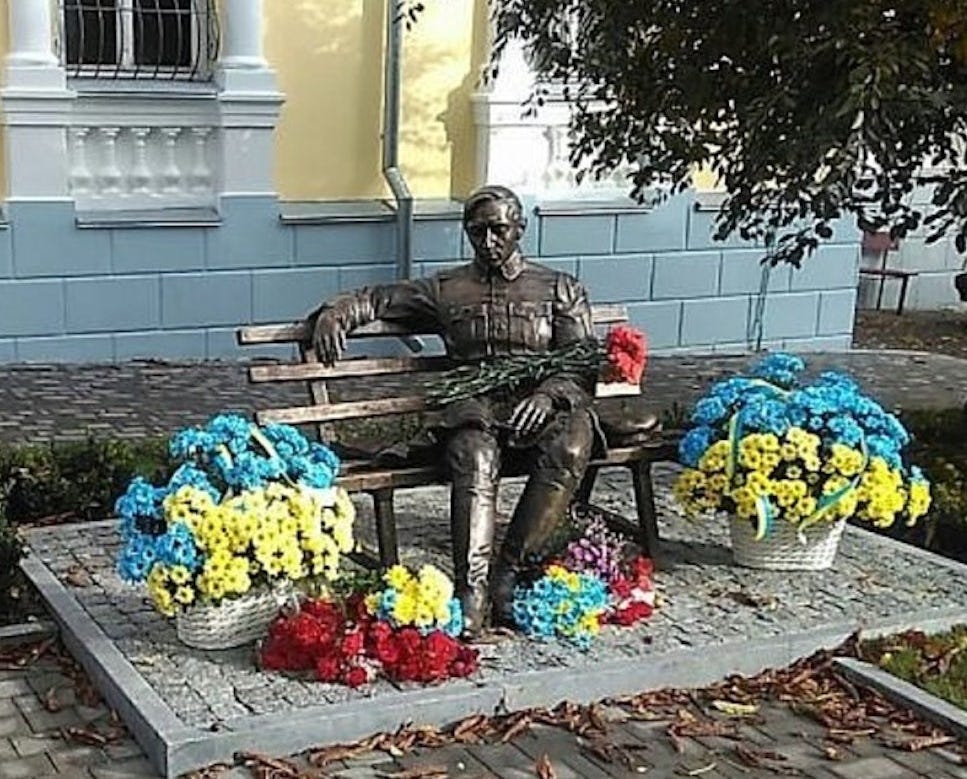Stepan Bandera Monument, Lviv (Galicia)
UKRAINIAN STATEHOOD
Some historians trace Ukrainian statehood back to Kievian RUS of the 9th century. Others believe Kievian RUS was the beginning of modern Russia; however, Kievian RUS was destroyed by the mongol invasions in the 14th century, whereas Muscovite Russia, also confronted by these invasions, maintained its statehood and continues to exist as a sovereign state.
The Ottoman Turks conquered what we call Ukraine today. This area was taken from the Turks by Catherine the Great in the 18th century. Despite the wonderful historical writings of Myjhailo Hrushevsky (1) and the existence of the tenuous Ukrainian government in 1917 during the Russian Civil War, Ukrainian statehood never really existed until the breakup of the Soviet Union in 1991.
Some argue that after WWII, a sovereign Ukraine was represented in the UN. It was still a vassal province of the Soviet Union, participating in the government in Moscow. This was unlike sovereign East European Countries such as Poland, although vassal states, were not participating in the Soviet government in Moscow.
THE UKRAINIAN SPACE
In the “Ukrainian space” without statehood, Ukrainians, Poles and Russians had lived in such close coexistence for centuries that they had become culturally and linguistically quite similar. It was part of the great Slavic people. “Ukraine” meant “The Borderlands”. The conquering Turks called it “The Ukraine”. Indeed, in todays world Russian, Belorussian and Ukrainian languages are almost interchangeable. Ukraine was referred to over the centuries as “Little Russia”. After Catherine the Great took Ukraine from the Turks she created “The Pale of Settlement” which was mostly in Ukraine. Here is where the Jews were allowed to live and prevented from emigrating into “Big Russia”. “The Pale” was the big target for “The Holocaust” in World War II. Some would say “The Holocaust” commenced before the beginning of the war and had begun in Galicia.
GALICIA: THE DRIVING FORCE FOR MODERN UKRAINIAN STATEHOOD
Primarily as a result of the territorial settlements from WWI, The Austrian province of Galicia experienced a strong irredentist movement for Ukrainian statehood. We will look at six men that lead Galicia in its drive for a Ukrainian State. To understand what is Ukraine today it is imperative that we have a geographical understanding of where was, and where is Galicia. It’s the fountainhead of Ukrainian Nationalism. To simplify the history, we can start with a Brittanica map depicting the three partitions of Poland in the 18th century. During the Third Partition, Russia received Ruthenia and Austro-Hungary received Galicia.
Note : Ruthenia, now a part of current Ukraine from the Dneiper up to, but not including Lviv. By the end of the 18th century the spoken languages were Belorussian, Russian and Ukrainian, variants of the old Eastern Slavonic language prominent in Kievian RUS.
And here is Galicia just before WWI: Cracow was the principal city in West Galicia and Lvov in East Galicia.
Galicia was part of the Austro-Hungarian Empire. Here is the map just before WWI. The brown crescent shape just below Poland and above Slovakia is Galicia.
The map of this part of Europe was redrawn at the Paris Peace Conference of 1918. Unfortunately Galicia was not recognized as a state and was divided eventually between Poland, Ukraine, Romania and Slovakia. KEY POINT!
Since Russia surrendered to Germany in 1917, she was not a part of the Peace Conference. After the conference Poland took over West Galicia. East Galicia was given to Russia in 1923 by the League of Nations after the Treaty of Rapallo.
EARLY UKRAINIAN NATIONALISM AND SIX LEADERS. THE 20s,30s
During the nineteenth century, as a province of the Austro-Hungarian Empire, Galicia experienced a strong Ukrainian irredentist movement targeting Russians, Poles, Slovaks and Jews. THE CITY OF LVIV WAS THE CENTER OF THIS MOVEMENT. The Jews were detested by the Galicians since they were considered the mercantile collaborators with Poland and Russia in controlling Galician peasant society. Poles, Russians and Jews were Galician Ukraine’s enemies in WWII during Galician collaboration with Nazi Germany. KEY POINT!
Here are some of the important players in the drive for a Ukrainian state. As you will see, they were fascists in there writings and comportment. As such they can be considered racist, ethnic cleansers. During the 20s and 30s fascism was in vogue in Europe. These people were part of it. We will see in Part Two of this Substack article that their racist murdering was whitewashed after they escaped to the West at the end of WWII. Then, they returned to Ukraine with their revised history, glorifying the fascists of the prewar and war periods. Ethnic cleansing is reborn and hidden in the sophisticated narrative of modern media.
Smytro Dontsov
Dontsov, from central Ukraine, studied in Vienna when Galicia was a Austrian province. He was the and is THE important irredentist writer for Ukrainian Nationalism. His early work on “Nationalism” and the need for a “Nation State” are seminal to Ukrainian Nationalism. Dontsov began to admire fascism in late 1922. By 1926 he had already translated parts of Hitler’s Mein Kampf into Ukrainian and published them. For Dontsov, Hitler was the ideal of a fascist leader. This Ukrainian ideologist compared Hitler to Jesus Christ and to Joan of Arc. In addition to extreme nationalism and fascism, Dontsov popularized antisemitism.” He was the principal inspiration for Stepan Bandera and the Organization for Ukrainian Nationalism (OUN) (2).
Ievhen Konovalets. OUN-UPA
After WWI he headed up the brief Kievian Ukrainian government supported by the victorious Germans over the Bolsheviks. In 1929 he was the founder of the OUN and became head of its military arm, the Ukrainian Nationalist Army (UPA) headquartered in Lviv. The OUN which he founded, seated in Lviv the center of Galician irredentism, became a killing machine agains Jews, Poles and Russians. Konovalets met Hitler in 1933 and appealed to Ukrainians “ to support the Fuhrer because he would open doors to the east”. Assassinated in Rotterdam in 1938 by Pavel Sudoplatov of Melitopol, Ukraine. As a member of the OUN he was considered a moderating force. However, his UPA became a killing machine. He was heavily implicated in the assassination of Pieracki, the Polish Interior Minister (3). By that time the OUN that he had founded had murdered countless human beings for the Ukrainian Nation’s cause.
Konovalets’ red and black flag of the UPA rears its head today as a symbol for Ukrainian street fighters and mass torchlight parades. The nasty UPA is not forgotten in modern, Galician dominated Ukraine. Today red and black flags are common in Ukraine. The flag and red and black masks are symbols of Sloboda, an ultra right wing group in today’s Ukraine.
UPA FLAG WITH NAZI WOLFSANGEL. Red and black Blut und Boden
A woman holds a portrait of Evgeny Konovalets during a festival in Poltava. Vladimir Zelensky named a battalion after him in October 2023. Photo Source and text from RT.
This is another connection of current Ukrainian Nationalists having synergies with early 1930s Ukrainian Right Wing having German Nazi affinities.
3. Stymon Petliura.
During the Russian Civil War 1917-1919 he was the head of the Ukrainian Army (UNA), the military arm of the brief Kievan Ukrainian government, headed by Konovalets. In 1926, Petliura was assassinated in Paris by Jewish anarchist Sholem Schwarzbard who had lost relatives in Petliura’s pogroms.(4). In October 2017 The World Jewish Congress stated that “ Petliura was anything but an honest man. He was a cruel barbarian, indisputably responsible for pogroms in which 35,000-40,000 Jews were murdered.” (5))
Above is a 2018 monument to Petliura in Vinnitsa Ukraine. Here is another example of the connection between early fascist Ukrainian Ultranationalists and today’s Ultranationalists.
Stepan Bandera, the OUN, 30s
This period is dominated by the rise of Stepan Bandera. Bandera was the Fuhrerprinzip of the OUN, a term, as noted above, used by Dontsov for leader of a fascist Ukraine. Bandera was eventually assassinated in Munich, 1958. His current mythical rise to national idol is evidenced by Ukrainian streets and monuments named after him, the most important of which is the monument in Lviv, a city on the current Ukrainian-Polish border. Lviv was the epicenter of early Ukrainian Nationalism, a movement that was determined to have an ethnic pure Galician Ukraine and to avenge the division of Galicia as described above. As we will see Bandera and his followers espoused fascism, anti-semitism, and were against Poles, Slovaks, Romanians, Russians and the Greek Orthodox Church. Their organization was the OUN (Organization of Ukrainian Nationalists. They were overwhelmingly violent in their quest for Galician hegemony in Ukraine.
Bandera, was politically active as a student at the University of Lviv, which at that time was a Polish University. Advocating for Ukrainian Nationalism he worked his way to the leadership of the OUN.. was eventually arrested and tried amongst others for the planning and assassination of Polish Interior Minister Bronislaw Pieracki. “During the trial, one of the defendants, while passing the dock went towards the other defendants , RAISED HER RIGHT ARM AND SHOUTED “ SLAVA UKRAINI”. For performing the Ukrainian fascist salute she was punished with one day in a dark cell”(6). This is the first recorded example of the Ukrainian Fascist Salute which was to become as prevalent as the Italian and German Fascist Salutes.
Bandera was in and out of prison and eventually ended up in Germany during and after WWII. What is important to know is Stepan Bandera as Prinzefuhrer of Ukrainian Nationalism and the OUN was a fascist. As John Paul Himka states:
“OUN was indeed a typical fascist organization as shown by many of its features: its leader principle, (Fuhererprinzip), its aspiration to ban all other political parties and movements, its fascist style slogan (Slava Ukraini! Heroism slava!), its red and black flag, its raised arm salute, its xenophobia and antisemitism, its cult of violence, and its admiration of Hitler, Mussolini and other leaders of fascist Europe. What is not fascist here?” (7)
Bandera is responsible for his followers’ pogroms, murders of Jews, Poles, Russians, and Slovacks. He is THE HERO of the leaders and followers of today’s Ukrainian government that has named streets and erected monuments to him. Fascinating are current torchlight parades lead by Bandera images.
HERE IS TODAY’S UKRAINE’S NATIONAL HERO IN HIS OWN WORDS:
“The OUN values the life of its members, values it highly; but—our idea in our understanding is so grand, that when we talk about its realization, not single individuals, not hundreds, but millions of victims have to be sacrificed in order to realize it” (4).
CONSIDER THIS NATIONAL HERO’S STATEMENT AS WE WITNESS THE RECENT TORCHLIGHT PARADES AND THE YOUNG UKRAINIANS DIEING IN THE WAR AGAINST ETHNIC RUSSIAN UKRAINIANS.
5. Andriu Melnuk and the OUN-M
Since Bandera was forced out of Galicia, the OUN was divided into OUN-B for the Bandera followers and OUN-M for Mel’nyk followers. This happened in Rome in 1939 at an OUN Congress. In a letter to Joachim Von Ribbentrop in 2 May 1938, Mel’nyk claimed the the OUN was ideologically akin to similar movements in Europe, especially to National Socialism in Germany and Fascism in Italy (8). Interesting is “the introduction of the Ukrainian Fascist Salute by the OUN-M (Mel’nyk) at the Second Great Congress of Ukrainian Nationalist in March-April 1941”(9).
Here is an OUN-B parade from October 1941 of Ukrainian youth in full costumes, in honor of Hans Frank, a prominent German Nazi. Note the raised arm Ukrainian Fascist Salute. (10)
UKRAINIAN COLLABORATION WITH NAZI GERMANY. 1939-1945
Roman Shukhevych
Shukhevych is second in-line after Bandera for adulation by today’s Ukraine. Once WWII broke out, OUN Ukrainian Nationalists were firmly on the side of Hitler’s Germany. Roman Shukhevych commanded a Ukrainian battalion during Operation Barbaross, Germany’s attack on Russia.
Following Barbarossa he continued to collaborate with the Nazis and from February 1941 to December 1942 he was the commanding officer of the German Nachtigall Battalion. He was the commander of the German Schutzmannschaft 201 auxiliary police battalion in late 1941 and 1942, otherwise known as The Schuma 201. (Wikipedia)
According to Canadian historian John-Paul Himka “no one has specifically studied the activities of Schuma 201 in relation to the destruction of the Jewish population. But we do know – wrote Himka – that the Germans routinely used the Schuma battalions in Belarus both to fight partisans and to murder Jews”.(11,12).
According to the Times of Israel: “At the outset of Operation Barbarossa in the summer of 1941, Roman Shukhevych commanded the Nachtigall Battalion, a volunteer unit operating under the orders of the Organization of Ukrainian Nationalists (OUN), as a subunit commanded by the German Abwehr special operations unit”. In other words, he was an actual Nazi.
“His OUN-dominated military formation served in German uniform, and its soldiers participated in the brutal Lviv pogrom. In 1942, Shukhevych commanded the Schutzmannschaft Battalion 201, a Ukrainian auxiliary police formation serving under Heinrich Himmler’s Higher SS and Police Leader (Höhere SS- und Polizeiführer, HSSPF) which carried out brutal pacification operations in Belarus. From 1943, after defecting German service, he served as supreme commander of the Ukrainian Insurgent Army (UPA), which carried out systematic massacres of Polish and Jewish civilians”. (The Times of Israel, November 22, 2022)
In 2016, after the 2014 Maidan Coup a new monument to Shukhevych, which is one of many in Ukraine erected after The Maidan in 2014.
STALIN AND YALTA, February 1945
The territorial fate of Ukraine and Galicia was decided at Yalta. Since Stalin had the upper hand he redrew the Polish borders. He attached Eastern Poland to Ukraine SSR and as compensation to Poland he took territory from Germany and annexed it to Poland. In the map the pink goes to Ukraine SSR and the brown to Poland.
END OF WWII
After Germany’s great military defeats at Stalingrad and Kursk, and knowing that the German Nazis were disinclined for a Ukrainian State, the OUN-UPA, without halting the murder of Jews, Poles, and Ukrainian Russians, secretly began their liaison with The West. The 14th Galician Waffen SS Brigade featured in my “Canadian Nazis…” on Substack is a perfect example of continued cooperation with Himmler while they worked their escape to the West with the collaboration of The CIA and the British MI6. More later.
SUMMARY AND………….WHAT’S NEXT?….ETHNIC CLEANSING RETURNS?
Is this section we have witnessed the tragic buildup and decline of Fascist Ukrainian Ultranationalism originating from Galicia. The Ukrainian leaders, operating from Lviv, the center of Galician Ukrainian Revanchism, will return, rewrite history and control the levers of power in Ukraine today. In Part Two we will observe Galician rebirth and ethnic cleansing in partnership with the power-seeking West. We will see these personalities as we have the old Galicians. The subtle ethnic cleansing in this case is to marginalize ethnic Russian Ukrainians, induce them to move to Russia, limit their Press, forbid the Russian language in schools, force them to eschew the Russian language in their daily life and clear them out to create an ethnically pure Ukraine……ALL THIS YEARS BEFORE RUSSIA’S INCURSION INTO THE DONBAS, February 22, 2022.
FOOTNOTES
Hrushevsky, Mykhailo. A History of Ukraine. Edited by Oliver J. Frederiksen. Pref by George Vernadsky. Hamden, CT: Archon Books. 1970. 629 p. (Published fot the Ukrainian national association)
2. Rossolinski-Liebe. Stepan Bandera: The life and afterlife of a ukrainian nationalist: fascism, genocide, and cult. Ibidem-Verlag Stuttgart. 2014. 652 p.
3. ibid. pp. 67,69,7o, 77,165
4. Schacht, Ben. TheUkrainian Poet-Assassin Who Avenged the Pogroms and Got Away With Murder. Jacobin.com,12,26,2022.
5. World Jewish Congress, 2017 cited in wikipedia.
6. Rossolinski-Liebe, pp.139,140.
7. Quoted in Per Anders Rudling, “The OUN and the UPA, and the Holocaust", p.4. cited in Hilferty, Lian John. “Glory to the heroes…” Univ Vt Dissertation. 2022.
8. Rossolinski-Liebe. p. 71.
9. ibid, p. 462
10. Rossolinski-Liebe Gregorz. “The Fascist Kernal of Ukrainian Genocidal Nationalism”. The Carl Beck Papers, University of Pittsburg. 2015 no. 2402. Cover photo courtesy of Norodowego Arciwum Cyfrowego syg. 2-3022.
11. Per Anders Rudling, University of Alberta. The Shukhevych Cult in Ukraine : Myth Making With Complications. Cited in footnote 4 Wikipedia Schutzmannschaft Battalion 201.
John Paul Hikma Op_Ed. True and False Lessons from the Nachtigall Episode. Cited in footnote 5 Wikipedia Schutzmannschaft Battalion 201.
NO NUKES —Humanity
FREE JULIAN ASSANGE—Justice
KNOWLEDGE IS POWER—Scott Ritter
TO UNDERSTAND RUSSIA WE HAVE TO UNDERSTAND OURSELVES—Michael Basta
OPEN THE KENNEDY FILES—Americans who want to understand ourselves















Check my 3 minute summary of the war by the brilliant David Sacks! I wish it would go viral so Americans can see what is happening to us.
Thank you. What a mistake! I’ll correct. Thanks